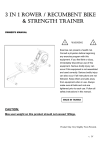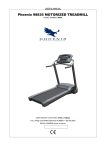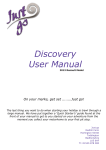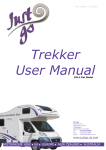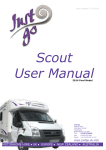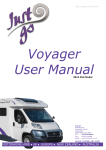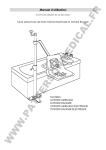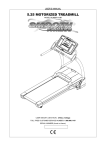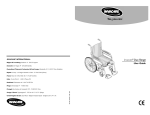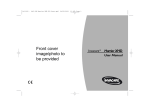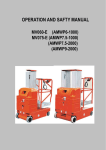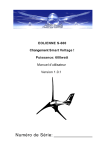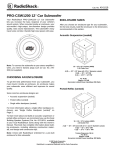Download Duo Service Manual
Transcript
Invacare ®Duo Range Service/Maintenance Manual 1 Introduction This manual provides basic details to enable the Invacare® DUO RANGE™ Wheelchair to be maintained. It is not intended to be a comprehensive maintenance guide/policy, but is intended for use by authorized personnel to enable the chair to be adequately maintained. The Wheelchair is manufactured by: INVACARE Ltd South Road Bridgend Industrial Estate Bridgend Mid-Glamorgan CF31 3PY Invacare provides the following documentation in regards to the Duo Range wheelchair, User Manual, Spare parts list and Prescription forms. All of these documents are provided for on the Invacare web site or by contacting Customer Services Sales/Technical Services Telephone: Sales Fax: Technical Services Fax: Email: Web: 01656 647327 01656 649016 01656 753299 [email protected] http://www.invacare.co.uk For TECHNICAL ADVICE, repairs, servicing, contact Technical Services. For SPARE PARTS orders contact Customer Services. Quote the following details at all times: Part Number (see Spare Parts Catalogue) Description Quantity required Serial Number Chair Type This manual contains copyrighted information. This manual may not be reproduced or reprinted either partly or completely without previous written consent from Invacare® or its statutory representatives. We reserve the right to make any necessary alterations on the grounds of technical improvements. 2 Policy INVACARE Ltd Policy is as follows: Repairs to any component other than those detailed in this manual are not covered. Repairs to any tube metal work are not generally permitted without express permission of INVACARE Ltd. All fasteners i.e. bolts, Nyloc nuts, and any fastener showing damage must be renewed. Under no circumstances attempt to repair a crash damaged chair. Contact Technical Services for further Information. Alterations to the wheelchair which occur as a result of incorrectly or improperly executed maintenance or overhaul work lead to the exclusion of all liability on the side of INVACARE. We reserve the right to make any alterations on the grounds of technical improvements. Information about operation or about general maintenance and care work should be taken from the wheelchair User Manual. Failure to comply with the above absolves INVACARE Ltd of liability. Note: Certain components will require removal to carry out maintenance. These components should be refitted. Product End of Life Even though your Powerchair has been designed to provide a long and trouble free life it is inevitable that wear, tear and usage will eventually render the product unusable. INVACARE recommends that the average usable life of this product is five years, providing the product has been correctly maintained according to the manufacturer’s recommendations. When the time comes to replace your wheelchair please remember to dispose of the product responsibly and recycle any recyclable parts as mentioned in this user guide. Notes on Transport If the wheelchair has to be shipped back to the manufacturer for major repairs, you should always use the original packaging for transport. You should also include as accurate a fault description as possible. Information Symbols NOTE: This symbol identifies general information which indicates special points or simplifications in dismantling / reassembly. CAUTION: It is imperative that you observe any safety instructions identified with this symbol. TOOLS/SERVICE: This symbol identifies service work or tools required. EXPLOSION HAZARD! This symbol warns you of an explosion hazard, which can be caused by excessive tyre pressure in a pneumatic tyre! Always follow the instructions to avoid injury to the user or damage to the product! TRANSPORTATION: This symbol identifies important information relevant to transporting your wheelchair in a motor vehicle. 3 Contents Section Page 1 Layout of Duo Range 5-6 2 Safety and Assembly Instructions 7 3 Tools Required 8 4 Technical Detail 9 5 Intended Use 10 6 Backrest Assembly 11 – 12 7 Backrest Extension Assembly 13 – 14 8 Armrest Assembly 15 – 16 9 Rear Wheel Assembly – Transit 17 – 18 10 Rear Wheel Assembly – Self Propel 19 – 21 11 Brake Assembly 22 – 23 12 Castor Wheel Assembly 24 – 25 13 Swing Away Footrest Assembly 26 – 27 14 Manual Elevating Swing Away Footrest Assembly 28 – 29 15 Seat Canvas Assembly 30 - 31 16 Duo Fitting/Removing Anti tipper 32 – 33 17 Duo Important Labeling Positions 34 - 35 4 1 Layout of Duo Range Duo Self Propelling Wheelchair 1 2 8 7 4 6 1 2 3 4 5 Backrest assembly Armrest assembly Self propelling rear wheels Manual Brake assembly 5 5 6 7 8 Castor assembly Footplate assembly Hanger assembly Seat canvas 3 Duo Transit Wheelchair 1 2 8 3 7 4 6 1 2 3 4 Backrest canvas Armrest assembly Transit Rear wheels Brake assembly 6 5 5 6 7 8 Castor assembly Footplate assembly Hanger assembly Seat canvas 2 Safety and assembly instructions These safety instructions are intended to prevent accidents at work your suitable workshop environment and it is imperative that they are observed. 2.1 Before any inspection or repair work Read and observe this maintenance manual and the associated user manual. Caution: Prop up the wheelchair with appropriate supports before starting the disassembly or assembly. Never use standard nuts instead of self-locking nuts. . When using loctite use goggles and gloves 2.2 Before operation / after completion of work: Caution: Check all fixings for tight fit (Ref torque settings where applicable). All nyloc nuts should be replaced with new after removal Check brake assembly fully locks and that chair is unable to move. Check hand grips are secured cannot twist or pull off. Check that folding back plunger locks securely into lower back post when push handle is in the upright position Check seat and back upholstery are in a good condition Check footrest is correctly fitted Check hanger assembly is in working order and correctly fitted. If anti tippers are fitted they are firmly locked in place. Lap belt is securely fitted and in good condition Check brazed parts are in good condition Only operate wheelchair with correct tyre pressure. (When applicable) Check that Transportation tie down labels are visibly in good condition (Replace if necessary). As a last check, always carry out a trial run. 2.3 Disposal/Recycling Components • • • • • • 7 The equipment wrapping is potentially recyclable. The metal parts are used for scrap metal recycling. The plastic parts are used for plastic recycling. Electric components and printed circuit boards are disposed of as electronic scrap. Disposal must be carried out in accordance with the respective national legal provisions. Ask your city or district council for details of the local waste management companies. 3 Tools Required The following list gives the basic tools required to perform the maintenance procedures as illustrated in this manual. None of which are supplied by Invacare. Open End Spanner (10mm) Open End Spanner (11mm) Open End Spanner (15/16”) Open Ended Spanner (17mm) Open Ended Spanner (19mm) Socket / Wrench (19mm) Open Ended Spanner (22mm) Open Ended Spanner (24mm) Open Ended Spanner (26mm) Cross Point Screwdriver Flat Bladed Screwdriver Nylon Mallet Torque Wrench Hexagon Wrench - (4mm) Hexagon Wrench - (5mm) Knife Pressure Gauge Pump Valve Remover Pair Pliers Safety Goggles Gloves Note: Ensure cleaning/Disinfecting of product is followed before carrying out any maintenance, pay attention to the following points: Only use a damp cloth and gentle detergent. Do not use any abrasive or scouring agents. Do not use any high-pressure cleaning devices. 8 4 Technical Detail 4 The following data applies to the Duo range of wheelchairs. 4.1 Available Standard seat sizes: 15 inches by 16 inches, 16 inches by 16 inches, 17 inches by 17 inches and 18 inches by 17 inches. 4.2 Available Heavy Duty seat sizes: 20 inches by 17 inches, 20 inches by 18 inches, 22inches by 17 inches, 22 inches by 18 inches, 24 inches by 17 inches and 24 inches by 18 inches. 4.3 Seat to ground height: 19 inch. 4.4 Wheel types available: 12 ½ inch transit with pneumatic or solid tyre. Fixed to frame. 22 inch Self-Propelling pneumatic or solid, Quick Release or Bolt On. 4.5 Maximum standard & Heavy Duty user weight:` Standard 19.5 stones (125kgs) and Heavy Duty 25 stones (160kgs) 4.6 Backrest type: Folding backrest or Fixed Vertical 4.7 Chair Colour: Powder coated black. 4.8 Approximate weight of chair Standard and Heavy Duty size Standard size Transit chair 19.5Kg Standard size Self Propel chair 22.5Kg Heavy Duty size Transit chair 22Kg Heavy Duty size Self Propel 25Kg Note: The chair is available in various defined optional types. Refer to Invacare Ltd Prescription forms or for further assistance contact Invacare Customer Services 9 5 Intended Use Environmental Use The Standard Duo Range is an Indoor and Outdoor configurable wheelchair offered with various options compliant with EN12184:1999 section 5 class B The Heavy Duty Duo Range is an Indoor and Outdoor wheelchair with various options compliant with EN12184:1999 section 5 class B. Type of User The Standard Duo Range has been designed to provide mobility and comfort for persons with impaired mobility. The Heavy Duty Duo Range has been designed to provide mobility and comfort for persons with impaired mobility. Manner of Use The Standard Duo Range has been designed to be used either/or by a seated user/carer/attendant in both indoor and outdoor environments The Heavy Duty Duo Range has been designed to be used either/or by a seated user/carer/attendant in both indoor and outdoor environments Standard Use The Standard Duo Range has, in its standard format, been designed to accommodate users who weigh up to a maximum of 125kg, have all limbs intact and have sufficient upper body strength to maintain a safe position within the wheelchair without the addition of supporting aids. The Heavy Duty Duo Range has, in its standard format, been designed to accommodate users who weigh up to a maximum of 160kg, have all limbs intact and have sufficient upper body strength to maintain a safe position within the wheelchair without the addition of supporting aids. Specialist Use Adaptations from the standard wheelchair format are available to accommodate users who do not meet the above criteria but these will only be considered after a suitable assessment of the risks has been carried out by a qualified person. For example a user with either a full or a partial amputation or other condition which affects the natural Centre of Gravity will need to have a stability evaluation to minimize the risk of inadvertent tipping. Standard Recommendations The wheelchair should only be used in accordance with the safety advice given within this user guide. Failure to follow the recommended advice within this user guide could lead to personal injury. Specific Recommendations No claims are made that the product will medically improve the circumstances or condition of the user. 10 5 Backrest Assembly 1 2 3 UNLOCK 4 5 8 LOCKED 7 6 9 10 View of rear Backrest Assembly 11 12 13 1 2 3 4 5 6 7 11 Backrest canvas Hand grips Push handles Plunger knob ¼” x 28 UNF M6 Pivot bolt Plunger Countersunk M6 ID washer 8 9 10 11 12 13 M6 Nyloc nut Counter sunk screw Cup washer Push Bar Hand Knob Lap Belt 5 Backrest Assembly 5.1 Tools Required Open ended Spanner (10mm) x 2. Cross point screw driver 5.2 Inspection 1. 2. 3. 4. 5. 6. 7. Check that the backrest canvas is not unevenly stretched, worn or torn. Check that all stitches are in good condition. Check that all screws and washers are secured, in good condition and are not burred. Check pivot bolt is secured. Check plunger assembly is secure and functional. Check hand grip cannot twist or pull off. Check that lap belt is secure and locking mechanism is functional. Note: Testing has confirmed hair spray is sufficient to secure hand grip to push handle. (Recommend Tescos Value hairspray). 5.3 Disassembly/Assembly 1. 2. 3. 4. 5. 6. 7. Lock brakes to prevent movement of chair Unscrew push bar hand knobs to remove push bar (only applicable to Heavy Duty Models) Unscrew and remove the top four countersunk screws and cup washers. Unscrew and remove the bottom two countersunk screws, cup washers and lap belt. Unscrew and remove the two button head M6 pivot bolts, nyloc nuts and washers. Hold the push handle, and slide the lower half of the backrest canvas off. Hold the backrest canvas and slide the push handle out. To re-assemble reverse the above steps, ensuring that the fixation holes in the upholstery and tubes are aligned. Making sure that all fixation screws are hand tight. Caution: When removing/replacing fasteners from backrest assembly ensure you replace the nyloc nuts. When replacing plunger knob ensure you apply loctite solution 243. When using hairspray please following safety guidelines on hairspray can. 12 6 Backrest Extension Assembly 9 10 2 1 3 4 5 6 7 8 1 2 3 4 5 13 Backrest canvas Hand Grips Push Handles Plunger Knob Pivot Bolt 6 7 8 9 10 Plunger Counter sunk screw Cup washer Backrest Extension Hand Knob 6 Backrest Extension Assembly 6.1 Tools Required Cross point screw driver 6.2 Inspection 1. 2. 3. 4. Check that the backrest extension canvas is not unevenly stretched, worn or torn. Check that all stitches are in good condition. Check that all screws and washers are secured, in good condition and are not burred. Check that hand knobs are securely fitted. 6.3 Disassembly/Assembly 1. 2. Lock brakes to prevent movement of chair. Remove the four Hand knobs from the backrest extension tubes. To re-assemble reverse the above steps, ensuring that the fixation holes in the upholstery and tubes are aligned. Making sure that all fixation screws are hand tight. Note: Assembling backrest extension for the first time. Follow instructions below. 6.4 Disassembly/Assembly of Backrest Extension for the first time 1. 2. Remove counter sunk screws from push handles. Fit four hand knobs through extension tubes and secure to the push handles. To re-assemble reverse the above steps, ensuring that the fixation holes in the upholstery and tubes are aligned. Take care not to over tighten fixation screws. 14 7 Armrest Assembly VIEW WHEN LOCKED VIEW WHEN UNLOCKED 1 2 3 4 5 1 2 3 15 Armrest Pad Sealing Plug Armrest Frame 4 Counter Sunk Screw 5 Skirt Guard 7 Armrest Assembly 7.1 Tools Required Cross point screw driver 7.2 Inspection 1. 2. 3. 4. Check that frame and panel are in good condition. Check that armrest pad is in good condition and securely fastened. Check that armrest locking mechanism is functional. Check that sealing plug is secure and in good condition Note: For ease of maintenance the armrest assembly can be purchased as a complete assembly. 7.3 Disassembly/Assembly 1. 2. 3. 4. Lock brakes to prevent movement of chair. Rotate locking mechanism in forward position and lift out armrest assembly from side frame. Remove skirt guard by holding the armrest frame firmly whilst push the skirt guard forward. Unscrew and remove both counter sunk screws. Remove armrest pad from armrest frame. To re-assemble reverse the above steps, ensuring that the fixation holes in the tube are aligned. 16 8 Rear Wheel Assembly - Transit 1 2 3 1 2 17 Solid Transit Rear Wheel Pneumatic Transit Rear Wheel 4 3 Star Loc Washer 4 7/16 UNF Lock Nut 8 Rear Wheel Assembly - Transit 8.1 Tools Required Open Ended Spanner (19mm) Socket / Wrench (19mm) Nylon Mallet Torque Wrench 8.2 Inspection 1. 2. Check wheel is not buckled or physically damaged. Replace if required. Check tyre for wear (and correct inflation when applicable), both wheels should allow the same degree of wear (see side of tyre for pressure rating). Check that lock nut is secured to the axle bolt. Check brake alignment is horizontal to tyre. Check brake functionality. 3. 4. 5. Note: For ease of maintenance the transit rear wheel assembly can be purchased as a complete assembly, or by purchasing tyre and inner tube (if pneumatic). Caution: Take care while supporting the wheel chair in order to remove the wheel. 8.3 Disassembly/Assembly 1. 2. 3. Raise and support the chair so that the damaged wheel is free of the ground. Remove lock nut and star loc washer using suitable size spanner. Remove the wheel free from its location on the side frame. To re-assemble reverse the above steps, ensuring that the wheel is securely fitted. 8.4 Disassembly/Assembly of Pneumatic Tyre 1. 2. 3. 4. 5. Refer to 8.3 for removal of wheel assembly. Remove tyre using suitable tyre levers. Remove inner tube (when applicable). Replace inner tube or tyre as appropriate. Inflate tyre to correct inflation To re-assemble reverse the above steps, ensuring that the wheel is securely fitted. Explosion Hazard: Never exceed the pressure on the side walls of the tyre, otherwise, the tyre may explode and cause injuries! Caution: Apply loctite solution 243 to the thread of the wheel shaft and ensure that the transit wheel locknut is tightened to a torque setting of 30 – 40Nm. 18 9 Rear Wheel Assembly – Self Propel 3 1 2 6 4 5 8 7 1 2 3 4 5 Solid Self Propel Rear Wheel Pneumatic Self Propel Rear Wheel 24” Self Propel Rear Wheel Position 22” Self Propel Rear Wheel Position 20” Self Propel Rear Wheel Position 19 9 6 7 8 9 Set Forward Position. Fixed Wheel Only Standard Position. Fixed and Quick Release Set Back Position. Fixed and Quick Release Handrim Spacer Fitting 9 Rear Wheel Assembly – Self Propel 9.1 Tools Required 4mm Hexagon wrench 10mm Open ended spanner 11mm Open ended spanner 19mm Socket/Wrench 22mm Open ended spanner 26mm Open ended spanner Torque Wrench 9.2 Inspection 1. 2. Check wheel is not buckled or physically damaged. Replace if required. Check by hand that each quick release wheel locates correctly in both quick release axle bushes. Ensuring that the ball bearings protrude fully to secure a locked position. Check that there is no significant sideward movement. Check that fixed axle lock nut is fully secured. Check that handrim is in good condition and secure. Check tyre for wear (and correct inflation when applicable), both wheels should allow the same degree of wear (see side of tyre for pressure rating). Check that spokes for tension and general condition. Check brake alignment is horizontal to tyre. Check brake functionality. 3. 4. 5. 6. 7. 8. 9. Note: For ease of maintenance the self propel rear wheel assembly can be purchased as a complete assembly. Caution: Take care while supporting the wheel chair in order to remove the wheel. Handrims are constantly in contact with your hands. Make sure that they are not damaged. Explosion Hazard: Never exceed the pressure on the side walls of the tyre, otherwise, the tyre may explode and cause injuries! 9.3 Disassembly/Assembly of Quick Release rear wheel 1. 2. 3. 4. Raise and support the chair so that the damaged wheel is free of the ground. Push in and hold the black plastic quick release button located at the centre of the hub. Pull the wheel assembly out of the wheel mounting bush. Remove the axle from hub. To re-assemble reverse the above steps, ensuring that the wheel is securely fitted. 9.4 Disassembly/Assembly of Fixed rear wheel 1. 2. 3. Raise and support the chair so that the damaged wheel is free of the ground. Remove lock nut and star loc washer using suitable size spanner. Remove the wheel free from its location on the side frame. To re-assemble reverse the above steps, ensuring that the wheel is securely fitted. Caution: Apply loctite solution 243 to the thread of the wheel bolt and ensure that the self propel wheel locknut is tightened to a torque setting of 30 – 40Nm. 20 9.5 Adjusting a Quick Release axle 1. Using a suitable socket on the nut and a suitable spanner on the axle end, adjust to give a secured fit into the axle bushes. Ensure that each quick release wheel locates correctly in both quick release axle bushes. Ensuring that the ball bearings protrude fully to secure a locked position. 2. Note: This is confirmed when the black plastic button on axle is fully protruded. 9.6 Disassembly/Assembly of Handrim 1. 2. 3. 4. Raise and support the chair so that the damaged wheel is free of the ground. Place the wheel assembly on a suitable surface, or lock to prevent it rotating. Unscrew and remove the six screws and spacer fittings securing the hand rim to the wheel assembly. Recover the six spacers. To re-assemble reverse the above steps, ensuring that the wheel is securely fitted. 9.7 Location of Self Propel Rear Wheel Assembly 1. 2. 3. 4. 5. 6. Diagram 3 shows the correct setting position for the mounting block to locate a 24” rear wheel assembly. Diagram 4 shows the correct setting position for the mounting block to locate a 22” rear wheel assembly. Diagram 5 shows the correct setting position for the mounting block to locate a 20” rear wheel assembly. Diagram 6 shows the correct Set forward position for fixed wheels only. Diagram 7 shows the correct Standard position for fixed/QR wheels. Diagram 8 Shows the correct Set back position for fixed/QR wheels. Caution: When removing/replacing fasteners from Wheel mounting block ensure you replace the nyloc nuts. We advice a torque setting of 10Nm. When removing/replacing a quick release wheel mounting bush ensure you replace hexagon nut using thread loc solution 243. We advice a torque setting of 65 – 75Nm. Repositioning the rear wheel will affect the stability of the wheelchair. 21 10 Brake Assembly 1 2 1 Brake Assembly For Self Propel 22 2 Brake Assembly For Transit 10 Brake Assembly 10.1 Tools Required 5mm Hexagon wrench 10.2 Inspection 1. 2. 3. Check that brake assembly fully locks and the chair is unable to move. Check that brake action is positive and is not stiff. Check that the brake shoe is horizontal to wheel assembly. Note: For ease of maintenance the brake assembly can be purchased as a complete assembly. Note the setting position of the brake assembly. 10.3 1. 2. 3. Disassembly/Assembly Ensure that brake assembly is in the unlocked position. Loosen two socket head screws. Remove the brake assembly from its location. To re-assemble reverse the above steps, ensuring that the wheel is securely fitted. Note: Brake shoe should be positioned 2 – 5mm from tyre. Caution: Keep fingers away from movable parts to prevent injuries. 23 11 Castor Wheel Assembly 1 2 3 4 1 2 Castor Assembly 7½” x 1¼” Solid Castor Assembly 7½” x 1¾” Solid 24 3 Castor Assembly 5” x 1” Solid 4 Castor Assembly 5” x 1¾” Solid 11 Castor Wheel Assembly 11.1 Tools Required 24mm Open ended spanner Torque Wrench 11.2 Inspection 1. 2. 3. 4. 5. 6. 7. Check that castor fork is in good condition and secured to frame Check that the tyre is not cracked or excessively worn. Check that the tyre is firmly fitted and concentric within the rim. Check that castor wheel rotates freely when lifted clear of the ground and spun. Check all four wheels sit correctly to ground and function correctly. Check that wheel spokes are undamaged and in good condition. Check that there is no damage on thread of mounting stud. Note: For ease of maintenance the castor wheel assembly can be purchased as a complete assembly. 11.3 1. 2. 3. 4. Disassembly/Assembly Raise and support the front of the chair. Unscrew the castor assembly from the wheelchair frame using a suitable sized spanner on the nut above the castor fork until the assembly releases from its location Remove the castor wheel assembly. Check that the thread form inside the wheelchair's side frame is clean and undamaged. To re-assemble reverse the above steps, ensuring that the wheel is securely fitted. Caution: Apply Loctite 243 and ensure that the thread of the castor fork assembly mounting stud is tightened to a torque of 60 - 80N.m 25 12 Swing Away Footrest Assembly 1 2 3 4 5 1 2 3 26 6 Location Holes Hanger Assembly Locking Latch Mechanism 4 Adjustment Bolt 5 Footplate Assembly 6 Heel Loop 12 Swing Away Footrest Assembly 12.1 Tools Required 10mm Open end spanner Flat bladed screwdriver 12.2 Inspection 1. Check that footplate is undamaged, fitted securely to the Hanger assembly, swivels up and down smoothly and is effectively supported in a horizontal position. Check that heel loop assembly is undamaged and securely fastened to the Footplate Assembly. Check that locking latch mechanism functions correctly and the footrest assembly locks securely in place. Check that hanger assembly is undamaged. Check that location holes are undamaged, free of excessive paint and can be attached to side frame lug. 2. 3. 4. 5. Note: For ease of maintenance the swing away footrest assembly can be purchased as a complete assembly. 12.3 1. 2. 3. 4. Disassembly/Assembly Lock brakes to prevent movement of chair. Remove the R-clip from side frame lug. Lift the swing away footrest assembly from the side frame locating lug. Loosen adjustment bolt to adjust or remove the footplate assembly. To re-assemble reverse the above steps. 27 13 Manual Elevating Swing Away Footrest Assembly 1 2 3 4 5 6 7 8 9 10 1 2 3 4 5 28 Location Holes Stability Warning Label Locking Latch Mechanism Height Adjustment Lever Hanger Assembly 6 7 8 9 10 Calf Pad Calf Pad Adjustment Bracket Adjustment Bolt Heel Loop Footplate Assembly 13 Manual Elevating Swing Away Footrest Assembly 13.1 Tools Required 10mm Open end spanner 11mm Open end spanner 13mm Open end spanner Cross point screwdriver 13.2 Inspection 1. Check that footplate is undamaged, fitted securely to the Hanger assembly, swivels up and down smoothly and is effectively supported in a horizontal position. Check that heel loop assembly is undamaged and securely fastened to the Footplate Assembly. Check that locking latch mechanism functions correctly and the footrest assembly locks securely in place. Check that hanger assembly is undamaged. Check that location holes are undamaged, free of excessive paint and can be attached to side frame lug. Check that calf pad bracket is secure and functions smoothly. Check that height adjustment lever functions smoothly and is secure when in set positions. Check that warning label is fitted and in good condition. 2. 3. 4. 5. 6. 7. 8. Caution: The fitting of elevating legrests to wheelchairs may affect the stability of the wheelchair. Note: For ease of maintenance the manual elevating swing away footrest assembly can be purchased as a complete assembly. 13.3 1. 2. 3. 4. Disassembly/Assembly Lock brakes to prevent movement of chair. Remove the R-clip from side frame lug. Lift the manual elevating swing away footrest assembly from the side frame locating lug. Loosen adjustment bolt to adjust or remove the footplate assembly. To re-assemble reverse the above steps. 29 14 Seat Canvas Assembly 1 2 3 4 5 6 1 2 3 30 Countersunk screw Cup washer Seat Canvas 4 Threaded Nut Insert 5 Upholstery strip 6 Countersunk Screw location Hole 14 Seat Canvas Assembly 14.1 Tools Required Cross point screwdriver 14.2 Inspection 1. 2. 3. 4. Check that the seat canvas is not unevenly stretched, worn or torn. Check that all stitches are in good condition. Check that all screws and washers are secured, in good condition and are not burred. Check condition of upholstery strip Note: For ease of maintenance the seat canvas assembly can be purchased as a complete assembly. 14.3 1. 2. Disassembly/Assembly Lock brakes to prevent movement of chair. Unscrew and remove the countersunk screws and cup washers. To re-assemble reverse the above steps, ensuring that the countersunk screws and cup washers are securely fitted. 31 15 Duo Fitting / Removing Anti-Tippers 2 1 3 4 1 2 32 Frame location for Anti tipper Anti tipper 3 Locking spring 4 Anti tipper fixed position 15 Duo Fitting / Removing Anti-Tippers 15.1 Tools Required No Tools required 15.2 Inspection 1. 2. 3. Check the function of the wheel Check the function of the locking spring Check that the anti tipper fits securely into position. Note: The locking spring buttons should be fitted in the central location as shown in picture 3. 15.3 1. 2. 3. 15.3 1. 2. Assembly Depress the locking spring buttons on anti tipper assembly. Engage the anti tipper into the side frame rear tube. Position locking spring buttons with hole in the rear side frame tube. Disassembly Depress the locking spring buttons on anti tipper assembly. Disengage the anti tipper from the side frame rear tube. Note: The same assembly/disassembly applies to Self Propelling rear wheels Note: The anti tippers are not to be used as tipping levers. Note: Invacare recommend that anti tippers are always fitted whenever the wheelchair is being used. 33 16 Duo Important Labeling Positions Note: For ease of maintenance the transportation tie down label can be purchased from Invacare. 16.1 Rear Transportation tie down label position 16.2 Front Transportation tie down label position 34 16.3 Manual Elevating Stability warning label position 16.4 Duo Identification serial label 35 United Kingdom and Ireland: 36 28/08/2009 Part Number 1504409 Invacare Ltd. South Road, Bridgend Industrial Estate Bridgend County Borough of Bridgend CF31 3PY United Kingdom




































